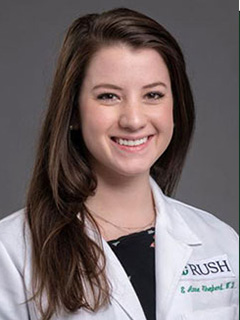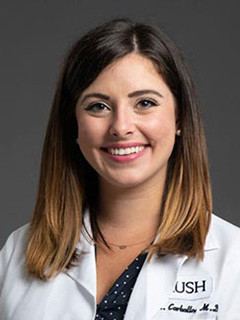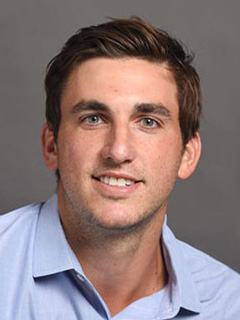
Residency training in ophthalmology at Rush University Medical Center is a four-year program accredited by the Accreditation Council for Graduate Medical Education. Each year, three residents are appointed to begin their ophthalmology training following a pre-ophthalmology internship year which is now integrated into our program at Rush University.
The mission of the ophthalmology program is to train residents in excellent medical and surgical care of patients with all types of eye disease. The program emphasizes continuity-of-care, with residents following patients continuously from the beginning of their training.
There are more than 40 active physicians who are dedicated to resident training. One hundred percent of the ophthalmology faculty at Rush are private practice based, which is one of the strongest advantages of the program. The faculty are present for one reason, and one reason only, resident education! During every clinic, our faculty are present to provide guidance on the evaluation and treatment of every resident patient.
-
Image

The preliminary year at Rush is a tailored and diverse experience that enables interns to establish and mold their identity as new doctors. Included in this year are both medical and surgical experiences that are curated to establish a comprehensive medical foundation and complement a future career in ophthalmology. Rotations include general medicine and medical sub-specialties, including dermatology and infectious disease; and general surgery and surgical sub-specialties, including ENT and plastic surgery. The year ends with three months in ophthalmology, allowing for a gradual and more structured introduction to the specialized language and examination procedures of ophthalmology. Multiple in-depth lectures on basic ophthalmology as given. Residents also begin supervised examination of 1 to 4 patients each day, allowing for a guided introduction to all the new concepts being encountered.
PGY 1 Rotations:
- Infectious Disease Inpatient Service (4 weeks)
- Internal Medicine Inpatient Service (4 weeks)
- Neurology (4 weeks)
- Dermatology (4 weeks)
- General Surgery (4 weeks)
- ENT (4 weeks)
- Plastic Surgery (4 weeks)
- Emergency medicine (2 weeks)
- Rheumatology (2 weeks)
- Hematology (2 weeks)
- Ophthalmology (12 weeks)
“The transitional year at Rush is the best of every world. You get the opportunity to work across a variety of healthcare settings, inpatient and outpatient, within the Rush system. While it sounds like you are floating around throughout the year, you are classified under the internal medicine department so you always have a home base. All of this helps orient you to the Rush Epic platform and to get to know the people, services, and resources that will help you through your residency. Logistics aside, Rush fosters such a productive and constructive learning environment and you make a lot of great friends along the way. This already fantastic years ends with 3 consecutive months of Ophthalmology to get you oriented before you dive in full-fledge!" - Palak Patel, M.D.
-
Image

The first year in ophthalmology is an introduction to outpatient general ophthalmic care, subspecialty ophthalmic care, ophthalmic surgery and ophthalmic pathology. Each resident assists attending physicians in intraocular surgery. Residents work in the resident continuity clinic so they develop a practice of their own patients from day one. These patients see you, the resident, as their doctor, and trust your opinion and recommendations. Throughout the year, PGY-2 residents become more comfortable with clinical decision-making, in-office procedures (ex. chalazion excisions), and laser procedures (ex. Selective laser trabeculoplasty and Panretinal photocoagulation). The ophthalmic pathology rotation consists of one-half day per week for 6 months. First-year residents are on call one to two days per week. Backup coverage is provided by the third-year resident and an attending at all times.. The expectation is that the PGY-2 resident is increasing his or her knowledge base to be able to recognize commonly seen ophthalmic conditions, while becoming more comfortable working up patients, and developing basic surgical skills.
“We begin taking primary call July 1st and are typically on call 1-2 weekdays a week and one weekend a month. As interns we spend three months at the end of the year (April to June) on ophthalmology so come July 1 we are ready for call. The chief (residents) provide great support while on call and are just a phone call away at all times.
Our main surgical experiences as primary surgeons during the first year are plastics procedures, temporal artery biopsies, and glaucoma lasers, such as diode and micropulse procedures. We complete a wide range of eyelid procedures in the main hospital operating room, surgicenter, and our clinic procedure room. Our procedure room is currently being utilized for blepharoplasties and mullerectomies. We also scrub for retinal procedures which often use Ngenuity 3D heads-up display. There are different blocked times for surgeries and you will scrub for a wide range of surgeries in both the anterior and posterior segments, such as complicated cataracts, glaucoma drainage procedures, and corneal transplants.” - Emily “Annie” Shepherd, M.D.
-
Image

PGY-3 year focuses on increasing decision making abilities. Residents spend a large amount of their time in clinic seeing patients, diagnosing and treating a variety of pathology and start doing more intraocular surgery. Often, second year residents are doing pediatric and adult strabismus surgeries; anterior segment surgeries like pterygium excisions and cataract surgeries; and some early retina surgeries, including core vitrectomies and scleral buckles.
“After feeling like you’re barely treading water in the first year of ophthalmology residency, second year is when things finally start to click. You’re still taking primary call and working in the resident clinic during the week, but now you really start to feel like you’re in control. You feel like an ophthalmologist (almost). There are patients whose clinical course you’ve been following since they presented to you in one of your first urgent clinics of PGY-2 year, and you can recite their history and disease course without reviewing their chart. You greet them like old friends and they view YOU as their doctor since you have been the most consistent face they’ve seen. Not only have you developed relationships with your patients, but you have developed relationships and mentorships with the various subspecialty attendings. Your presentations become more of a discussion as you continue to develop your own management plans. Second year is also the time you start to perform more ocular surgeries like strabismus and your first solo cataracts. With the third year residents spending a lot of their time in the OR, you most often find yourself immersed in clinic, learning the nuances of exam and management techniques that build on all the basics you learned last year. It’s these nuances that also help you to become a skilled and attentive surgeon. Second year really prepares you take ownership of your patients as you build towards the higher surgical volumes of third year." - Sarah Carballo, M.D.
-
Image

In the final year of residency, PGY-4 residents take on addition responsibilities of being chief resident. Faculty try to instill a level of autonomy in patient care and in a resident’s medical and surgical decisions. Now that patients have been seeing you, the resident, as their physician for the last 2-3 years, they are very comfortable discussing their care directly with you. PGY-4 residents become completely immersed in ophthalmic surgeries, and are primary surgeons on a variety of complex cataract surgeries; anterior segment surgeries (including scleral and iris fixated intraocular lenses); corneal procedures (including PKP, DSEAK, DMEK, DALK); glaucoma procedures (including MIGS procedures, tubes, trabs, etc). Each year, one of the third-year residents is selected to act as chief resident for administration, while the other handles educational matters. This system allows residents to develop administrative and educational maturity that will prove beneficial in their future careers.
“My final year as a resident a Rush provided a complete immersion into surgical ophthalmology – including the decisions leading up to surgery, technical skill development, and post-operative management. I felt encouraged to try new techniques, and use the latest technology, lasers and devices to broaden my experience. Most of all, the continuity clinic at Rush allowed me to step into a leadership role and take responsibility of patients with just the right amount of supervision. Rush fully prepared me to practice comprehensive ophthalmology, and in my case fostered and supported my decision to pursue fellowship training.” - Jonathan Minkowski, M.D.
-
Opportunities exist for clinical research throughout the three ophthalmology years; in-depth research is not, however, a prerequisite for completion of the program. All residents, however, are required to perform a structured research project to be presented at the Annual Resident & Alumni Day conference in June. They are also encouraged to present at national and international ophthalmology conferences and submit their research projects for publication before they graduate.
-
Each section director oversees the development of the morning clinical lecture series, assuring complete attention to the basic fund of knowledge required over a three-year cycle. Wednesday afternoons are dedicated to resident education; thus, no clinic is scheduled. Grand rounds are held monthly. Journal clubs are scheduled in cornea, neuro-ophthalmology and retina on a regular basis. Completing the didactic schedule, Chairman's rounds are held each month. Educational conferences are open to Rush residents throughout the year. For example, residents are able to attend the monthly conferences of the Chicago Ophthalmological Society, which features renowned outside speakers. From September to May, Rush residents participate in the Chicago Curriculum in Ophthalmology, a unique collaborative effort between all of the Chicago training programs; the lecture series is provided by faculty from each of the Chicago universities and is open to all Chicago ophthalmology residents.
-
Primary care education is an important component of the educational mission of the Department of Ophthalmology at Rush. Rush medical students, as well as students from other medical schools, may choose a two-week rotation in ophthalmology. A rotation in ophthalmology is required for residents in the departments of pediatrics and family medicine. In addition, residents in internal medicine may rotate through ophthalmology with the consent of their program director and the program director in ophthalmology. Rush ophthalmology residents take an active role in assisting in this student experience. We believe that there is no better way to learn than to teach.
-
The Rush Department of ophthalmology co-sponsors a highly successful two-year fellowship in retina and vitreous diseases. All fellows rotate through the department and greatly enhance the residency education experience. There is no competition for surgical cases between the residents and fellows who achieve their extensive surgical volume, outside of Rush, within the private practice of Illinois Retina Associates. The fellows also actively participate in resident journal clubs, academic conferences and didactic presentations.
